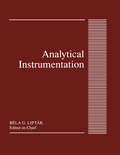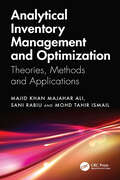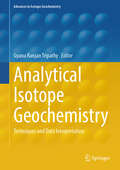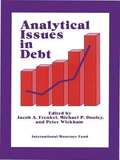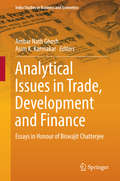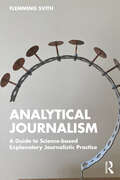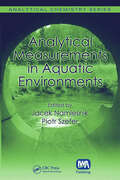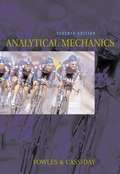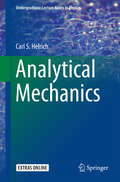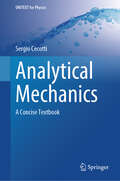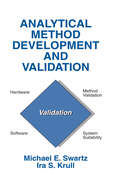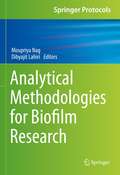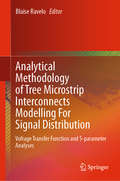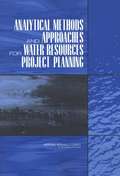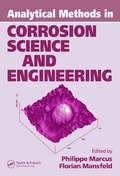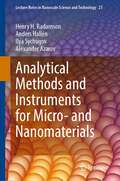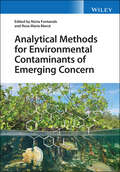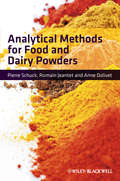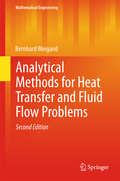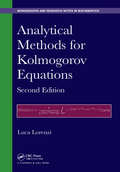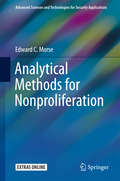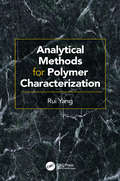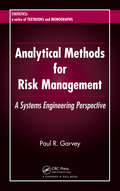- Table View
- List View
Analytical Instrumentation
by BelaG. LiptakAnalytical Instrumentation examines analyzers for detecting pollutants and other hazardous matter, including carbon monoxide, chlorine, fluoride, hydrogen sulfide, mercury, and phosphorous. Also covers selection, application, and sampling procedures.
Analytical Inventory Management and Optimization: Theories, Methods and Applications
by Majid Khan Majahar Ali Sani Rabiu Mohd Tahir IsmailIn this vital resource with discussion of and applicability to various industries, Ali, Rabiu, and Ismail guide readers through the challenging environment of inventory management and enable them to successfully balance the demand and supply of items in stock, a critical task in any field.The book covers a wide range of topics related to inventory management and optimization. After introducing the key concepts and principles of inventory management, such as inventory analytics, optimization, and models, the authors provide a comprehensive and in-depth understanding of various inventory control techniques that are essential for effective inventory management, such as ABC analysis, EOQ model, safety stock, and reorder point. They then introduce various mathematical models and optimization techniques such as system-level and item-level inventory analysis and show how to perform sensitivity analyses to test the robustness of these models. They then look at the role of inventory management in various industries such as supply chain management and logistics, manufacturing, and more; and address the effects and integration of cutting-edge technologies like artificial intelligence, machine learning, and robotics to conventional inventory management practices. Additional topics include inventory forecasting, inventory management systems, inventory auditing and control, risk management. In combining mathematical underpinnings in the area with practical case studies throughout, readers will gain a solid understanding of the real-world applications of these different techniques so that they can apply inventory management and optimization best practices in their workplace.The comprehensive coverage makes the book a valuable reference for practitioners and students, particularly postgraduate and MBA students, who require such insights to improve business functions and make informed decisions. Because it provides the foundational mathematical knowledge required to comprehend any chapter, it is also accessible for readers without a strong background in mathematics.
Analytical Isotope Geochemistry: Techniques and Data Interpretation (Advances in Isotope Geochemistry)
by Gyana Ranjan TripathyIsotopes of radiogenic and non-traditional stable elements have been extensively used for quantitative understanding of earth, planetary, ocean, and climatic processes. More recently, these applications have also been extended to medical, petroleum, forensic, and archaeological sciences. The proposed book aims at providing thorough analytical details for precise (ppm-level) isotopic measurements using state-of-the-art mass spectrometers (e.g., IRMS, TIMS, MC-ICPMS). All essential details on sample handling, chromatographic/solvent-extraction purification, isobaric interferences, spike-sample equilibration, data corrections, and measurement statistics for different isotopes have been reviewed here. It will also provide (i) information on recent technical analytical developments and (ii) &“do's-and-don'ts&” for analyzing isotopic ratios precisely. This book serves as an excellent handbook to set up these systematics with proper scientific rigor in academic and industrial laboratories.
Analytical Issues in Debt
by Jacob A. Frenkel Peter Wickham Michael P. DooleyA report from the International Monetary Fund.
Analytical Issues in Trade, Development and Finance: Essays in Honour of Biswajit Chatterjee (India Studies in Business and Economics)
by Ambar Nath Ghosh Asim K. KarmakarThe book's 30 chapters are divided into three sections - international trade, economic development, macroeconomics and finance - and focus on the frontier issues in each. Section I addresses analytical issues relating to trade-environment linkage, capital accumulation for pollution abatement, possibility of technology diffusion by multinational corporations, nature of innovation inducing tariff protection, effects of import restriction and child labour, the links between exchange rate, direction of trade and financial crisis--the implications for India and global economic crisis, financial institutions and global capital flows and balance of payments imbalances. Section II consists of discussions on the causes of widespread poverty persisting in South Asia, development dividend associated with peace in South Asia, issues of well-being and human development, implications for endogenous growth through human capital accumulation on environmental quality and taxation, the rationale for a labour supply schedule for the poor, switching as an investment strategy, the role of government and strategic interaction in the presence of information asymmetry, government's role in controlling food inflation, inter-state variations in levels and growth of industry in India, structural breaks in India's service sector development, and the phenomenon of wasted votes in India's parliamentary elections. Section III deals with the effectiveness of monetary policy in tackling economic crisis, the effective demand model of corporate leverages and recession, the empirical link between stock market development and economic growth in cross-country experience in Asia, an empirical verification of the Mckinnon-Shaw hypothesis for financial development in India, the dynamics of the behaviour of the Indian stock market, efficiency of non-life insurance companies, econometric study of the causal linkage between FDI and current account balance in India and the implications of contagious crises for the Indian economy.
Analytical Journalism: A Guide to Science-based Explanatory Journalistic Practice
by Flemming SvithResponding to an increasingly complex and often contradictory barrage of news information, Analytical Journalism offers a first-of-its-kind guide to this emerging form of science-based journalism. Posited as a practical alternative to other more traditional forms of event-driven news reporting, analytical journalism relies on metatheory and methodology to highlight causal factors such as goals, norms, behaviours and social frameworks when covering events. Seen as adjacent to investigative and data journalism, analytical journalism seeks to provide a solution to the simplification and under-reporting of the causal context by drawing on scientific research and data to offer a deeper understanding of news events. Central to this new field is public understanding; providing news consumers with the information they require to navigate and act with nuance in the real world. Drawing on the author’s experience of teaching analytical journalism at the postgraduate level, this book summarises the aims and theory of the field and contains practical tools to help improve journalists’ contribution to shared public knowledge, including methods and examples of identifying and justifying new causal explanations of an issue. Analytical Journalism will be of interest to advanced journalism students and practitioners exploring alternative forms of journalism.
Analytical Measurements in Aquatic Environments (Analytical Chemistry)
by Jacek Namieśnik Piotr SzeferEven a cursory perusal of any analytical journal will demonstrate the increasing important of trace and ultra-trace analysis. And as instrumentation continues to develop, the definition of the term "trace element" will undoubtedly continue to change. Covering the composition and underlying properties of freshwater and marine systems, Analytical Mea
Analytical Mechanics
by Louis N. Hand Janet D. FinchAnalytical Mechanics, first published in 1999, provides a detailed introduction to the key analytical techniques of classical mechanics, one of the cornerstones of physics. It deals with all the important subjects encountered in an undergraduate course and prepares the reader thoroughly for further study at graduate level. The authors set out the fundamentals of Lagrangian and Hamiltonian mechanics early on in the book and go on to cover such topics as linear oscillators, planetary orbits, rigid-body motion, small vibrations, nonlinear dynamics, chaos, and special relativity. A special feature is the inclusion of many 'e-mail questions', which are intended to facilitate dialogue between the student and instructor. Many worked examples are given, and there are 250 homework exercises to help students gain confidence and proficiency in problem-solving. It is an ideal textbook for undergraduate courses in classical mechanics, and provides a sound foundation for graduate study.
Analytical Mechanics
by Nivaldo A. LemosAnalytical mechanics is the foundation of many areas of theoretical physics including quantum theory and statistical mechanics, and has wide-ranging applications in engineering and celestial mechanics. This introduction to the basic principles and methods of analytical mechanics covers Lagrangian and Hamiltonian dynamics, rigid bodies, small oscillations, canonical transformations and Hamilton–Jacobi theory. This fully up-to-date textbook includes detailed mathematical appendices and addresses a number of advanced topics, some of them of a geometric or topological character. These include Bertrand's theorem, proof that action is least, spontaneous symmetry breakdown, constrained Hamiltonian systems, non-integrability criteria, KAM theory, classical field theory, Lyapunov functions, geometric phases and Poisson manifolds. Providing worked examples, end-of-chapter problems, and discussion of ongoing research in the field, it is suitable for advanced undergraduate students and graduate students studying analytical mechanics.
Analytical Mechanics (Seventh Edition)
by Grant R. Fowles George L. CassidayThis textbook is intended for an undergraduate course in classical mechanics taken by students majoring in physics, physical science, or engineering.
Analytical Mechanics (Undergraduate Lecture Notes in Physics)
by Carl S. HelrichThis advanced undergraduate textbook begins with the Lagrangian formulation of Analytical Mechanics and then passes directly to the Hamiltonian formulation and the canonical equations, with constraints incorporated through Lagrange multipliers. Hamilton's Principle and the canonical equations remain the basis of the remainder of the text. Topics considered for applications include small oscillations, motion in electric and magnetic fields, and rigid body dynamics. The Hamilton-Jacobi approach is developed with special attention to the canonical transformation in order to provide a smooth and logical transition into the study of complex and chaotic systems. Finally the text has a careful treatment of relativistic mechanics and the requirement of Lorentz invariance. The text is enriched with an outline of the history of mechanics, which particularly outlines the importance of the work of Euler, Lagrange, Hamilton and Jacobi. Numerous exercises with solutions support the exceptionally clear and concise treatment of Analytical Mechanics.
Analytical Mechanics: A Concise Textbook (UNITEXT for Physics)
by Sergio CecottiThis textbook is based on the author's lecture notes held at Qiuzhen College, Tsinghua University, Beijing, renowned for its rapid scientific growth of its excellent students. The book offers a remarkable combination of characteristics that are both exceptional and seemingly contradictory. It is designed to be entirely self-contained, starting from the basics and building a strong foundation in geometric and algebraic tools. Simultaneously, topics are infused with mathematical elegance and profundity, employing contemporary language and techniques. From a physicist's perspective, the content delves deeply into the physical aspects, emphasizing the underlying principles. This book bridges the gap between students and cutting-edge research, with a special focus on symplectic geometry, integrability, and recent developments in the field. It is designed to engage and captivate the reader. A conscious selection of topics ensures a more relevant and contemporary approach compared to traditional textbooks. The book addresses common misconceptions, offering clarity and precision. In its quest for brevity, this book is tailored for a one-semester course, offering a comprehensive and concise resource. The author's dedication is evident throughout this volume, encapsulating these goals within roughly 300 pages.
Analytical Method Development and Validation
by Ira S. Krull Michael SwartzDescribes analytical methods development, optimization and validation, and provides examples of successful methods development and validation in high-performance liquid chromatography (HPLC) areas. The text presents an overview of Food and Drug Administration (FDA)/International Conference on Harmonization (ICH) regulatory guidelines, compliance with validation requirements for regulatory agencies, and methods validation criteria stipulated by the US Pharmacopia, FDA and ICH.
Analytical Methodologies for Biofilm Research (Springer Protocols Handbooks)
by Moupriya Nag Dibyajit LahiriThe book provides the readers of various discipline an easy understanding of the latest biophysical techniques pertaining to microbiology. Biofilm associated chronic infection is a major health problem and a serious concern to doctors, scientists and other health workers as it develops antibiotic and multi-drug resistance. This book describes various protocols utilized in the detection of the biofilm. The book has been divided into six sub sections which provides pertinent information about the various biophysical techniques and instruments that are used for detecting and analyzing the biofilm formation upon biotic and abiotic surfaces. The readers will be able to identify the techniques that can best cater information to solve the problem at hand. This book attempts to compile the latest information on the recent advances in the various functional aspects of microbial biofilms, their pathogenesis, present day treatments as well as detection strategies.This book is meant for researchers in the field of microbiology and interested in understanding microbial pathogenesis, quorum sensing and biofilm formation.
Analytical Methodology of Tree Microstrip Interconnects Modelling For Signal Distribution: Voltage Transfer Function and S-parameter Analyses
by Blaise RaveloThis book focuses on the modelling methodology of microstrip interconnects, discussing various structures of single-input multiple-output (SIMO) tree interconnects for signal integrity (SI) engineering. Further, it describes lumped and distributed transmission line elements based on single-input single-output (SIMO) models of symmetric and asymmetric trees, and investigates more complicated phenomenon, such as interbranch coupling. The modelling approaches are based on the analytical methods using the Z-, Y- and T-matrices. The established method enables the S-parameters and voltage transfer function of SIMO tree to be determined. Providing illustrative results with frequency and time domain analyses for each tree interconnect structure, the book is a valuable resource for researchers, engineers, and graduate students in fields of analogue, RF/microwave, digital and mixed circuit design, SI and manufacturing engineering.
Analytical Methods And Approaches For Water Resources Project Planning
by Panel On Methods Techniques of Project AnalysisInformation on Analytical Methods And Approaches For Water Resources Project Planning
Analytical Methods In Corrosion Science and Engineering (Corrosion Technology)
by Philippe Marcus Florian MansfeldDamage from corrosion costs billions of dollars per year. Controlling corrosion requires a fundamental, in-depth understanding of the mechanisms and phenomena involved, and this understanding is best achieved through advanced analytical methods. The first book to treat both surface analytical and electrochemical techniques in a single reference, An
Analytical Methods and Instruments for Micro- and Nanomaterials (Lecture Notes in Nanoscale Science and Technology #23)
by Henry H. Radamson Anders Hallén Ilya Sychugov Alexander AzarovThis book describes analytical instruments widely used to characterize the nanostructured materials. It provides information about how to assess material quality, defects, the state of surfaces and interfaces, element distributions, strain, lattice distortion, and electro-optical properties of materials and devices. The information provided by this book can be used as a back-up for material processing, material design and debugging of device performance. The basic principles and methodology of each analysis technique is described in separate chapters, adding historic perspectives and recent developments. The data analysis, from simple to advanced level, is introduced by numerous examples, mostly taken from the authors' fields of research; semiconductor materials, metals and oxides. The book serves as a valuable guide for scientists and students working in materials science, physics, and engineering, who wish to become acquainted with the most important analytical techniques for nanomaterials.
Analytical Methods for Environmental Contaminants of Emerging Concern
by Núria Fontanals Rosa Maria MarcéAnalytical Methods for Environmental Contaminants of Emerging Concern Provides the analytical methodology required to detect different families of organic compounds of emerging concern (CECs) from environmental samples Most contaminants of emerging concern (CECs) —such as pharmaceuticals, personal care products, pesticides, sunscreens, perfluorinated compounds, and microplastics—have been present in the environment for years, yet some have only recently been identified, and many of these organic compounds remain unregulated. Analytical methods have been developed to determine the toxicity and risk of different families of CECs. Analytical Methods for Environmental Contaminants of Emerging Concern presents the methods currently available to determine families of organic CECs in environmental samples. Each section of the book is devoted to a particular family of CECs, covering different analytical methods supported by examples of both cutting-edge research and commonly used methods. An international panel of experts describes every step of the analytical procedures, including sample preparation, chromatographic separation coupled to mass spectrometry or other instrumental techniques. Specific requirements are linked to the properties of the contaminants and the sample matrix for each procedure presented. Throughout the book, in-depth case studies of analytical procedures for CEC extraction, separation, and determination are presented to help readers transfer the analytical methods to their laboratories. Provides detailed descriptions of various approaches for determining each group of CECs in environmental samples Covers different types of aqueous, solid, and atmospheric samples Includes up-to-date information on CEC properties, relevant legislation, reported or potential metabolites/transformation products, and environmental occurrence Addresses CECs such as novel psychoactive substances, artificial sweeteners, musk fragrances, disinfection byproducts, and microplastics Offers practical tips and advice on special care procedures to assist readers in CEC determination Analytical Methods for Environmental Contaminants of Emerging Concern is an essential reference and guide for advanced students and researchers in analytical chemistry and science, environmental science, forensic science, and specialized subjects related to analytical chemistry.
Analytical Methods for Food and Dairy Powders
by Anne Dolivet Romain Jeantet Pierre SchuckFood and dairy powders are created by dehydrating perishable produce, such as milk, eggs, fruit and meat, in order to extend their shelf life and stabilise them for storage or transport. These powders are in high demand for use as ingredients and as food products in their own right, and are of great economic importance to the food and dairy industry worldwide. Today, the ability to control food and dairy powder quality is a source of key competitive advantage. By varying the dehydration process design, and by controlling the technological and thermodynamic parameters during dehydration, it is possible for manufacturers to engineer the biochemical, microbiological and physical characteristics of the food powder to meet their specific product requirements.This book provides an overview of the existing, adapted or new techniques used to analyse safety and quality in modern food and dairy powders. Based on original research by the authors, the book uses 25 commercial dairy and non-dairy powders to illustrate a range of biochemical and physical methods used to evaluate and characterise powdered food products. Written from a practical perspective, each chapter focuses on a particular analytical technique, outlining the purpose, definition and principle of that method. The authors guide the reader through all of the instruments needed, the safety measures required, and the correct procedures to follow to ensure successful analysis. Instructions on accurate measurement and expression of results are included, and each chapter is richly illustrated with original data and worked examples.Analytical Methods for Food and Dairy Powders is a unique step-by-step handbook, which will be required reading for anyone involved in the development and manufacture of powdered food products. Food and dairy scientists based in industry will find it essential for new product development and improved quality control, while researchers in the laboratory will especially value the new techniques it comprises.
Analytical Methods for Heat Transfer and Fluid Flow Problems (Mathematical Engineering)
by Bernhard WeigandThis book describes useful analytical methods by applying them to real-world problems rather than solving the usual over-simplified classroom problems. The book demonstrates the applicability of analytical methods even for complex problems and guides the reader to a more intuitive understanding of approaches and solutions. Although the solution of Partial Differential Equations by numerical methods is the standard practice in industries, analytical methods are still important for the critical assessment of results derived from advanced computer simulations and the improvement of the underlying numerical techniques. Literature devoted to analytical methods, however, often focuses on theoretical and mathematical aspects and is therefore useless to most engineers. Analytical Methods for Heat Transfer and Fluid Flow Problems addresses engineers and engineering students. The second edition has been updated, the chapters on non-linear problems and on axial heat conduction problems were extended. And worked out examples were included.
Analytical Methods for Kolmogorov Equations (Chapman & Hall/CRC Monographs and Research Notes in Mathematics #25)
by Luca LorenziThe second edition of this book has a new title that more accurately reflects the table of contents. Over the past few years, many new results have been proven in the field of partial differential equations. This edition takes those new results into account, in particular the study of nonautonomous operators with unbounded coefficients, which has received great attention. Additionally, this edition is the first to use a unified approach to contain the new results in a singular place.
Analytical Methods for Nonproliferation (Advanced Sciences and Technologies for Security Applications)
by Edward C. MorseThis book is intended to be used as a textbook and research reference for the field of nuclear nonproliferation. The book is primarily technical and focussed on methods of detecting clandestine nuclear material that might be illicitly transported. The book also touches on nuclear forensics, i. e. methods for identification, attribution, and establishment of transport pathways for illicit nuclear material. Also covered are topics of methods used for arms control and treaty verification, and an assessment of technologies under development for all of the above. A description of the government and international agencies involved in nuclear terrorism prevention, nuclear safeguards, and arms control is also included.
Analytical Methods for Polymer Characterization
by Rui YangAnalytical Methods for Polymer Characterization presents a collection of methods for polymer analysis. Topics include chromatographic methods (gas chromatography, inverse gas chromatography, and pyrolysis gas chromatography), mass spectrometry, spectroscopic methods (ultraviolet-visible spectroscopy, infrared spectroscopy, Raman spectroscopy, and nuclear magnetic resonance), thermal analysis (differential scanning calorimetry and thermogravimetry), microscopy methods (scanning electron microscopy, transmission electron microscopy, and atomic force microscopy), and x-ray diffraction. The author also discusses mechanical and dynamic mechanical properties.
Analytical Methods for Risk Management: A Systems Engineering Perspective (Statistics: A Series of Textbooks and Monographs)
by Paul R. GarveyA Text on the Foundation Processes, Analytical Principles, and Implementation Practices of Engineering Risk ManagementDrawing from the author's many years of hands-on experience in the field, Analytical Methods for Risk Management: A Systems Engineering Perspectivepresents the foundation processes and analytical practices
